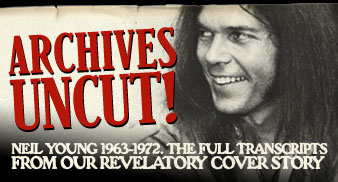DEAN STOCKWELL Actor, Topanga Canyon resident and long term friend of Young. Stockwell wrote the screenplay that inspired After The Goldrush *** UNCUT: How did you first meet Neil? STOCKWELL: My first real contact with Neil was when he was living in Topanga Canyon, as I was, in the late �...
DEAN STOCKWELL
Actor, Topanga Canyon resident and long term friend of Young. Stockwell wrote the screenplay that inspired After The Goldrush
***
UNCUT: How did you first meet Neil?
STOCKWELL: My first real contact with Neil was when he was living in Topanga Canyon, as I was, in the late ‘60s. And I had done a movie with Dennis Hopper in Peru, The Last Movie, and Dennis very strongly urged me to write a screenplay, and he would get it produced. I came back to Topanga and wrote a screenplay, After the Goldrush, that never got produced. But a copy of it somehow got to Neil. And as I understand it, he had had writer’s block for months and months and months, and his record company was after him. And after he read this screenplay, he wrote After the Goldrush in three weeks. And then even though I had the album, I still couldn’t get the screenplay produced…
What I know of the film is that it’s about an artistic community living in Topanga Canyon, and an earthquake causes a tidal wave that washes them away. Have I got that right?
That’s very loosely it. It’s not a linear, regular story-telling kind of film. Anyway, I got together with Neil. And when he got to do the album, he invited me to be there, at the studio attached to his house, for the recording of the whole thing, one of the great privileges I’ve ever been involved with. Some songs were worked up, some were fully-formed, but they were all pretty clear in his head, and communicated to the musicians.
After The Goldrush seems so pertinent to the culture at the start of the ‘70s. Was that sort of thing in your mind?
Well, really what was in my mind was that the goldrush in effect created California. And the film took place on the day California was supposed to go into the ocean. So that’s what happened after the goldrush.
Is there anything in the song “After The Goldrush” itself that relates directly to the screenplay.
It relates to it in an artistic way, not in a direct way, in dialogue or anything. That’s how he found himself in the screenplay, and how he saw it, which coincided beautifully with what I had in mind.
Do most of the songs on the album have some relation to the movie?
The whole rush of writing does, with the exception of “Southern Man”, that he had already recorded – thank God. In my opinion, Neil was always a great man. If not the top guy, then him and Bob. And a very funny fucking guy, man, let me tell ya. You’ve gotta be there for that. And generous. When he did After the Goldrush, the kid playing rhythm guitar, Neil provided this fantastic guitar for him to play, and gave it to him at the end, it was probably worth a couple of thousand dollars. But it was more a generosity of spirit. If you could calculate the amount of human energy that goes into the making and performing of one of his songs, you would have a really fucking high number man.
Was he a very intense person in the studio?
Oh yeah, but it wasn’t an intensity with any dark edges to it. He was very meticulous as a musician. Everybody has to understand what they’re playing and how they’re going about it just right, and they did. It didn’t present great difficulties for him to communicate those songs, they snapped to and did it perfectly. Whatever was required, he seemed to come up with.
So he was extremely mentally organised?
Oh, yeah.
What was special about Topanga Canyon?
Well, it was an old Indian sacred ground, and I think that vibration was part of what attracted an awful lot of interesting people. In addition to Neil and myself, Linda Ronstadt, Spirit, Taj Mahal and Wallace Berman lived there. It was loaded with talented and interesting people.
INTERVIEW: NICK HASTED



